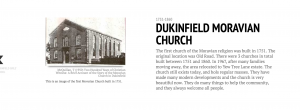The two modes of representation discussed in Grafton’s, Time in Print, are chronology and geography. By using these two modes of representation, it makes it easier for historians and researchers to piece or link together different pieces of information throughout history. Chronology allows one to determine the order of events while the geography allows one to determine where all of these events took place. The geography could help researchers determine common illnesses at that time in history or match together different groups that were in the same location at the same time. If researchers are able to determine the exact place something happened and the time it happened at, they can use this information and compare it to other information to clarify historical events.
Many times researchers have ideas about different events in history and how they are related. Researchers are able to use the two modes of representation, chronology and geography, to link together these events. Suppose there was a crime committed and there are two people in question. The detectives could use information about the place of the crime scene and the time the crime was committed at. They could then do research into the actions of these two people around the time of the crime and determine how close they were to the scene. These two modes allow researchers to relate events and arrive at conclusions that were otherwise be difficult to come to. Chronology can also be used in other ways. Grafton states, “For Christians, getting chronology right was the key to any practical matters such as knowing when to celebrate Easter and weighty ones such as knowing when the Apocalypse was nigh,” (Grafton 11). This mode of representation can be used to remember when specific calendar events occur or even predict when events in the future would occur.
On the other hand, knowing the time and place of a specific event could lead to incorrect assumptions about what happened at that event. One person may have just been in the wrong place at the wrong time and not been involved in the event but been mistaken as partaking in it. Chronology and geography cannot always verify events and link together some, but it can provide useful information that will aid in arriving at a conclusion even if it is not the correct one. Although at first glance, one may not think much of a timeline, I do believe it has the ability to tell a story. Grafton writes “Our claim is that the line is a much more complex and colorful figure than it is usually thought,” (Grafton 10). As one moves down the line, they pick up more and more useful information that they can then piece together to create a story. The line is of great importance, “In the graphic arts, the same holds true: from the most ancient images to the most modern, the line serves as a central figure in the representation of time,” (Grafton 14). As one can see, the line resembles much more than just something drawn on a paper.
a photo of how the events line up on the timeline


an example of one of the events on our timeline
Megan Koczur is a sophomore student at Bucknell University. She is a member of the Bucknell Swim and Dive team and intends on majoring in Computer Science and Engineering. She resides in West Chester, Pennsylvania with her her father, mother, sister, Erin, and two black labs, Brandy and Max.

1 reply on “Blog #3: Timelines”
After reading this blog post, I thought the example of a crime being committed was most interesting. I had not thought about this application of time and geography in this way before. I agree with idea that the “two modes allow researchers to relate events and arrive at conclusions that would otherwise be difficult to come to”. I talked about a similar idea in my own blog post when I discussed how we had to dive into databases and other academic platforms to discover information we would not have found otherwise.